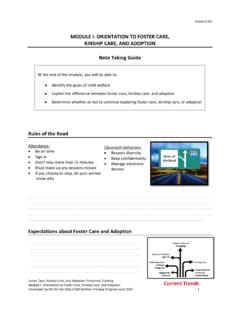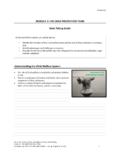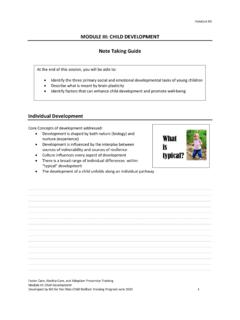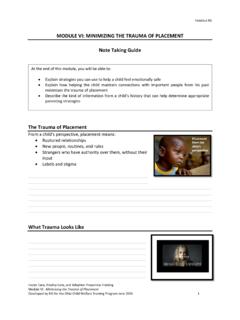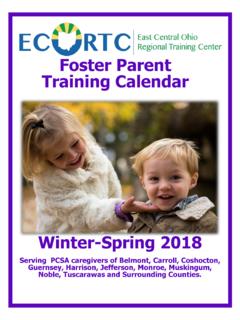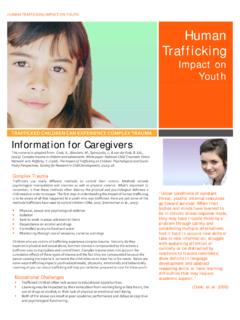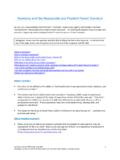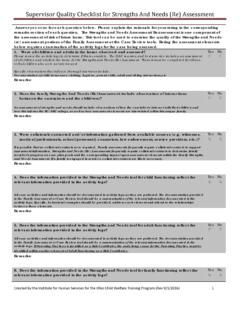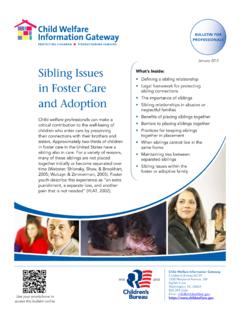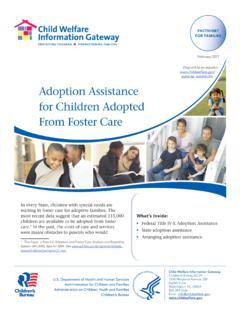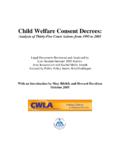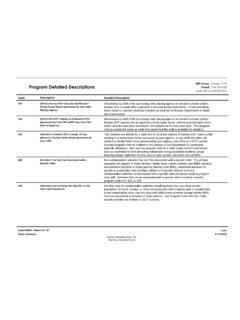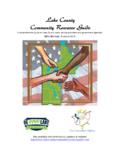Transcription of MODULE IX: UNDERSTANDING PRIMARY …
1 Handout #1 Foster care , Kinship care , and adoption Preservice Training MODULE IX: UNDERSTANDING PRIMARY families Developed by IHS for the Ohio Child Welfare Training Program June 2015 1 MODULE IX: UNDERSTANDING PRIMARY families Note Taking Guide Introduction Working with the PRIMARY family is an essential part of being on the child welfare team. Caregivers and adoptive parents need to have an UNDERSTANDING of the dynamics of PRIMARY families . _____ Collaboration Caregivers and adoptive parents must be aware of cultural differences and misassumptions that may be barriers to collaboration.
2 A significant number of PRIMARY parents have trauma histories. Strategies for collaboration include: Respect for one another Seek conflict resolution Permission for honesty Focus on the best interest of the child Communication At the end of this MODULE , you will be able to: Discuss common reactions to loss the PRIMARY parents may experience when their children are in out of home care Discuss the advantages to the child when there is positive interaction between PRIMARY parents and caregivers or adoptive parents Discuss ways caregivers or adoptive parents can involve the PRIMARY parents in decisions regarding the care of his or her child Explain the importance of maintaining strong sibling connections Handout #1 Foster care , Kinship care , and adoption Preservice Training MODULE IX.
3 UNDERSTANDING PRIMARY families Developed by IHS for the Ohio Child Welfare Training Program June 2015 2 _____ Reactions of families with Children in care families experience: Psychological distress or trauma Threats to self esteem Subjected to criticism and shame Conflict with strong cultural values Reduced income and financial security Emotional changes Reactions: Shock or denial Anger Bargaining Depression Acceptance _____ A Continuum of Contact Positive, stable relationships play a vital role in helping children heal from trauma.
4 PRIMARY parents with children in temporary custody retain residual parental rights. Frequent contact with PRIMARY family can help ease behavior problems, anxiety, and depression. Strategies for maintaining contact include: Be a support system Mentor Allow time for trust to develop Handout #1 Foster care , Kinship care , and adoption Preservice Training MODULE IX: UNDERSTANDING PRIMARY families Developed by IHS for the Ohio Child Welfare Training Program June 2015 3 ._____ Sibling Connections Siblings should be placed together.
5 If that isn t possible, they should have frequent opportunities for visitation. _____ List three ways you will use the information from this training: 1. 2. 3. Handout #2 Foster care , Kinship care , and adoption Preservice Training MODULE IX: UNDERSTANDING PRIMARY families Developed by IHS for the Ohio Child Welfare Training Program June 2015 1 MODULE IX: UNDERSTANDING PRIMARY families Myths and Realities Myth Reality PRIMARY parents who abuse, neglect, or relinquish their children do not care about them. PRIMARY parents do not plan to abuse or neglect children.
6 Maltreatment of children usually occurs following overwhelming stress. Parents who maltreat their children may, in fact, love their children dearly, but may not be able to cope with circumstances or may not know how to parent successfully. Furthermore, parents who voluntarily relinquish their children usually do so with tremendous ambivalence; they do not walk away from these relationships without significant, lifelong grief. Most PRIMARY parents are violent, dangerous people who pose a threat to the families caring for their children. Some PRIMARY parents have a history of violence or mental health problems that indicate risk for caregivers and adoptive parents.
7 Most PRIMARY parents, however, can build a collaborative relationship with caregivers that can be invaluable in the rapid reunification of the family. When the caseworker or caregiver or adoptive parent is unsure about the level of risk posed by a PRIMARY family, relationships should be built with deliberate care along a continuum of openness, with the safety of caregivers and adoptive parents of paramount concern. Foster and kinship families are expected to function as caseworkers or therapists for PRIMARY families . Foster and kinship families may serve in key roles as mentors with PRIMARY families .
8 When caregivers and PRIMARY families develop a partnership, this will be part of a total intervention plan developed by the child welfare team. The intervention planning will involve the caregiver and will spell out the expectations for the caregivers, when those interventions will occur, and why they are planned to improve the outcomes for the child. Handout #2 Foster care , Kinship care , and adoption Preservice Training MODULE IX: UNDERSTANDING PRIMARY families Developed by IHS for the Ohio Child Welfare Training Program June 2015 2 Myth Reality The agency is "setting up" foster and kinship careigvers or adoptive parents to be hurt by dangerous PRIMARY parents.
9 The agency will not expect caregivers or adoptive parents to place themselves at risk in working with PRIMARY families . The agency will always consider risks when developing a partnering plan, and caregivers or adoptive parents will be involved in the development of the plan. Communication between caregivers or adoptive parents and PRIMARY families may, at times, need to occur through an agency intermediary, usually the caseworker, to protect the safety of the child and the caregiver or adoptive parent. Foster and kinship families are expected to work with all PRIMARY families of children who come into care .
10 Foster and kinship families are expected to communicate with the PRIMARY parents of all children. That communication may take many forms, depending on the characteristics of the PRIMARY family, the wishes of the foster or kinship family, and the stage of the developing relationship between the caregivers and PRIMARY families . Relationships may begin with a journal of the child's progress, move into telephone calls between the PRIMARY and caregivers, meetings during supervised visits at the agency, and may eventually evolve into unsupervised visits at the foster, kinship, or PRIMARY family home prior to reunification.
